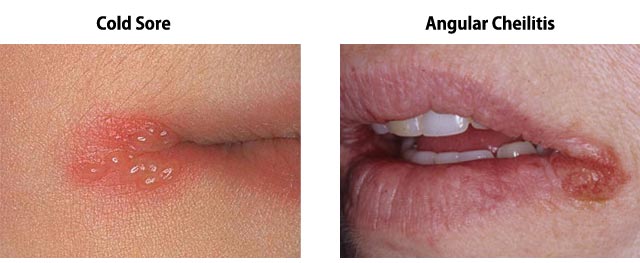Source: http://www.angularcheilitishelp.org/similar-mouth-illnesses.php#ixzz30oMg5u4A
Not surprisingly, angular cheilitis seems similar to many other mouth illnesses, which leads people to improperly diagnose themselves and use the wrong treatments. This page will go over all the mouth illnesses that people frequently confuse for angular cheilitis.Fever Blisters / Cold Sore (Herpes) vs Angular Cheilitis
Cold sores are caused by the HSV-1 (Herpes Simplex Virus) and on average heal on their own within 2-3 weeks. They symptoms start as a tingling/itchy sensation on or around the lips that will turn into a red area forming one or many small blisters. Eventually these small blisters will from a large red blister which will swell until it bursts creating a weeping ulcer. A scab will soon form and gradually get smaller as the cold sore heals until it is completely gone after 14-20 days.
Cold Sore Symptoms
|
Angular Cheilitis Symptoms
|

HIV vs Angular Cheilitis
Many people who read about angular cheilitis come across sites that say it is a common symptom of HIV. However, just because you have angular cheilitis does not indicate that you have HIV.
The reason websites claim angular cheilitis is a symptom of HIV is because HIV severely weakens your immune system which makes it easier for your body to get angular cheilitis more frequently. Normally our immune system fights off the bacteria/fungus that causes angular cheilitis before we notice it, however if we are ill, stressed, have had recent mouth trauma, or have had lack of rest it negatively effects our immune system which can cause angular cheilitis to form.
Mouth Ulcer vs Angular Cheilitis
Mouth ulcers are most common in 16-25 year old and rarely occur in people over 55. They are generally an open sore in the mouth that penetrates the mucus membrane within the mouth. They are most common on the inside of lips, on the inside of cheeks, beneath the tongue, and on the gums.
Mouth Ulcer Symptoms
|
Angular Cheilitis Symptoms
|

Chapped Lips vs Angular Cheilitis
Chapped lips can happen to anybody. It occurs when the lips become dehydrated either by dry air, the person not being hydrated, or by licking your lips. In some cases a person's lips can become so dry that they can crack which can make it look like angular cheilitis. However, it is not angular cheilitis. If your lips are severely chapped it can make it easier to get angular cheilitis, because it makes the skin around your mouth weaker and more susceptible to bacterial/fungal growth. So if you do have chapped lips, its important to stay hydrated and to keep your mouth moisturized to prevent angular cheilitis from developing.
Chapped Lips Symptoms
|
Angular Cheilitis Symptoms
|

https://blip.fm/caramenambahberatbadan
BalasHapushttps://www.linkedin.com/in/menggemukkan-badan-3213b5216/
https://caramenambahberatbadan.artstation.com/projects/oAEJYk
https://www.artstation.com/artwork/oAEJYk
https://www.himalaya.com/album/kars-lover-3234301
https://hub.docker.com/r/loverkars/cara_gemukin_badan
https://cara-menaikan-berat-badan.mystrikingly.com/
https://www.kaskus.co.id/thread/60d9e95ae35dc44cf00fe570/cara-menambah-berat-badan-10-kg-dengan-cepat
https://teletype.in/@caramenambahberatbadan/KI3VYJX9q7h
https://www.himalaya.com/album/kars-lover-3234301
https://social.microsoft.com/Profile/caramenambahberatbadan